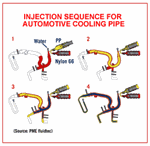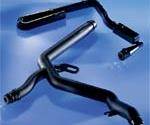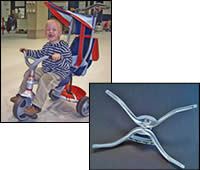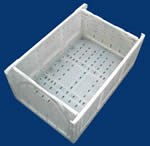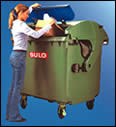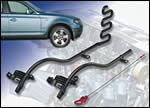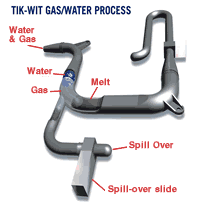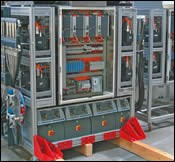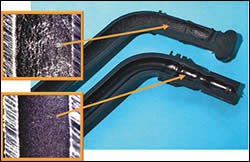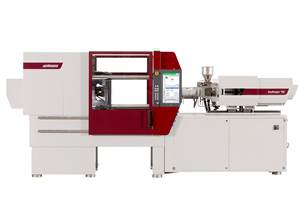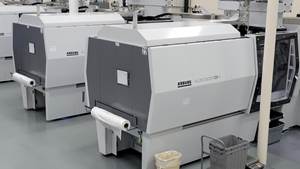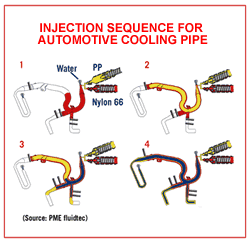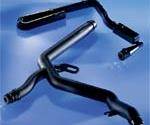Water Injection Molding: It's All Coming Together
Commercial applications in hollow-part molding with water—or water and gas—are starting to accelerate. They are driven by recent enhancements of process technology, equipment, and materials.
Water injection technology (WIT) is taking hollow-part injection molding into territory where gas assist hasn't gone before. In use for only about five years, WIT first found a following in coring out simple tube-shaped parts where it brought cooling cycle times down by as much as 70% from those seen with gas assist. Next, WIT broke into fluid-transport applications where it proved able to provide smoother inner walls than gas.
Now WIT is finding increasing use in larger and smaller part applications, thicker and thinner parts, and more complex shapes, where it can produce more uniform wall thickness and help simplify part designs. WIT has graduated beyond handles, brake pedals, and automotive cooling tubes into shipping crates, toys, furniture, and large waste bins. WIT's ability to pack out a part consistently can reduce sinks and warpage while lessening the degree of mold texturing required.
While commercial applications are multiplying, WIT is advancing rapidly. Improved injector nozzles seal off better to keep the process leak-free and the molding operation dry. New nozzles can inject water and gas and can also act as an outlet for water ejection from the part. In addition, new nozzles can be mounted flush with the mold to introduce water by breaking through the part surface, or they can protrude into the mold cavity and core directly from within the part.
Water delivery units come in newer volume- or pressure-driven configurations that allow users to better profile the pressure, volume, and timing of the coring process. At least one firm offers electric water pumps as an alternative to hydraulics.
WIT has also gained four new process capabilities:
- Use of multi-cavity tooling to core out several parts simultaneously.
- Injecting a sequence of gas and water in order to reduce the chance of "fingering" voids in the part wall.
- Circulating water through a part via multiple nozzles for added cooling.
- Creating a water circuit within a circular part from a water stream that is split and then rejoined without pressure loss.
The WIT process is also bound to get a boost from new simulation software that can model and analyze molding with water in 3D.
The number of suppliers offering WIT technology or components for it has increased. The newest player is from Germany and calls itself Technology in Kunststoff, or TiK for short. It has one brand-new commercial application for its TiK-WIT process and four or five projects all set to go into production. That firm competes with PME Fluidtec of Germany, the biggest player in the field with 45 to 50 commercial applications, including 18 new ones in the last year alone.
Meanwhile, injection machine supplier Engel says it has 14 commercial applications for its Watermelt process, including the only WIT application in the U.S. Eight of the systems work with four-cavity tools. Battenfeld recently announced the first commercial customer for its Aquamold system. Ferromatik Milacron has several projects for its Aquapress technology, though it—as well as Demag Plastics Group and Krauss-Maffei—uses the TiK-WIT process with water-delivery systems from Maximator in Germany.
Two suppliers of gas-assist technology now also offer WIT. Bauer Plastics Technology in the U.S. recently developed its First Class Controller–Water (FCC-W) system and water/air-injection pin. Cinpres Gas Injection sells its Water-Assisted Molding (WAM) system, which is based on patents from the former Alliance Gas Systems. And Gain Technologies has teamed up with PME Fluidtec to offer the WIT process in the U.S.
In addition, growth of WIT is being supported by the development of nylon grades designed expressly for WIT. BASF, DuPont, Lanxess, Rhodia, and A. Schulman all have new WIT nylons and more are in development. A. Schulman has gone one step further, developing compatible nylon and PP grades for two-component WIT parts. The company is also working on WIT with a recycled PET/PBT blend and with long-glass PP and nylons.
A stream of applications
At present count, there are more than 60 commercial WIT applications, the majority of them in Europe, where WIT originated. The jobs range from automotive to consumer goods and industrial applications, some of them previously manufactured with gas assist. The application range includes handles, clutch pedals, fascias, rocker covers, roof racks, door modules, shovels, brackets, chairs, and office furniture. Three leading-edge WIT applications include a children's tricycle, a collapsible beverage crate, and an oil dipstick guide.
The first commercial use of Battenfeld's Aquamold system started this year with the handlebars and front-wheel fork of a new tricycle from Smoby SA of France, the third largest toy manufacturer in Europe. The three parts are made from PP. The handlebars weigh approximately 400 g, while the front fork weighs about 350 g. What makes this significant is that it is one of the first consumer applications for WIT. The parts are fairly large for this process, and they have very thick walls—20 to 40 mm. According to Helmut Eckardt, technical director of process engineering at Battenfeld, WIT trimmed cycle times by 40% compared with gas.
At the other extreme is a long (450 mm), thin (15 mm O.D.) oil dipstick guide tube molded by Schneegans Silicon GmbH in Losenstein, Austria, for BMW 2-liter engines. It uses Engel's Watermelt process and a new WIT nylon grade from DuPont. It is molded with an initial shot size of 190 g, of which 50 g are displaced into an overflow well. The application has very thin walls and tight tolerances. The I.D. is only 8.5 mm and a 1-mm clearance for the dipstick must be held so that the fit is neither too tight nor too loose.
The growing sophistication of WIT includes the emergence of multicavity applications. Engel's first U.S. application for its Watermelt process is a 5.5-lb, PP collapsible crate. All five sides are molded in one tool, where four of the panels are cored out simultaneously using one Watermelt control module and water-delivery system. The 16 x 24 x 11 in. crate is designed for food transport. "The crate could be done with gas, but the cycle time would increase 15 to 20 sec,"says Joachim Kragl, Engel's manager of processing technology. With water, cooling is up to 70% faster than with gas, he notes.
The tool was produced by Haidlmair GesmbH, a major Austrian builder of molds for food and beverage crates. "The main benefit of WIT in this application is that the hollowed section eliminates structural supporting ribs and trims cycle times while retaining stiffness, strength, and reducing warpage, says Roland Gradauer, sales manager at Haidlmair. Each side panel is initially short-shot; then the water cores out a U-shaped channel 43 in. long, while displacing 200 g of PP from each part into a separate overflow well. Finally, another injector near the overflow valve injects air to expunge the water back into the recovery system.
Another large part (the largest yet made with PME Fluidtec's WIT process) is the domed lid for a new 1100-liter HDPE refuse bin made by Sulo Environmental Technology in Herford, Germany. The water hollows out a lip that provides structural support and acts as a water-runoff channel. The lid measures about 43.5 x 50 x 7 in. and weighs about 22 lb.
Other notable production applications include a PP rear window frame for the Volkswagon Golf, molded by Polytech Thermoplast GmbH of Idstein, Germany. It is the largest part yet made with PME Fluidtec's WIT process.
Steering heads for forklifts and tillers are molded of 30%-glass nylon 6 with the TiK-WIT process by Gebruder Frei in Albstadt, Germany. WIT reduces the need for ribs and bosses in the part design.
Molder Poppelmann Kunststoff Technik in Lohne, Germany, is using WIT to mold a chainsaw handle from 30% glass-filled nylon 6.
Gas & water together
Among suppliers of WIT technology, Cinpres and TiK both advocate use of gas and water injection in the same part for best results. Cinpres came to this conclusion after an extensive series of trials last year. It now recommends that "gas be used initially to form the hollow sections, water to cool the plastic and smooth the internal finish, and finally gas to exhaust the water.”
Water reportedly provides smoother internal walls than gas assist on its own, which is important in parts designed to transport fluids or gases. Water also cools the part much faster, delivering 40 times the thermal conductivity of gas and four times higher heat capacity. But this can have drawbacks, too. "If water cools too fast and pressure remains high, water can create voids in part walls or even break through the skin of the part,"explains Engel's Kragl. Materials like nylon with a fast crystallization rate set up quickly when cold water hits the hot melt, so the melt is less fluid and less able to flow and accommodate the incoming water, which is itself incompressible, unlike gas. Thus, the cold water can puncture or push aside the cooling melt front and break new channels within the part. This can leave cold slugs in the part or mar the inner part surface, says Marcel Op de Laak, CEO of TiK. Another potential problem with premature cooling is that glass fibers may be left projecting into the cored-out channel, impeding flow of fluid in the final application.
The solution is to use gas assist to do most of the work of coring out the part, which is completed by water. Gas also provides an efficient way to expel water from the part at the end of the molding cycle. This approach is particularly recommended for use with standard resins not optimized for WIT.
The Cinpres system has separate channels for compressed air and pressurized water, which meet at the injector nozzle. TiK's newest WIT process injects gas and water through the same nozzle. A defined volume of a gas "thermal cushion"stays in front of a defined volume of water, says Op de Laak. A novel aspect of the system is that it does not use compressed gas. The injector chamber contains only air at ambient pressure, which becomes compressed by the water following behind. Once the water pressure is reduced or cut off, the compressed air acts like a spring and pushes the water back out of the part.
TiK does not manufacture the water or gas delivery system. It has partnered with Maximator, which has developed a line of gas and water delivery systems. "Our expertise is in the mold, injectors, and the process,"says Op de Laak.
Equipment developments
PME Fluidtec has developed its first multicavity system for a European customer with a four-cavity application. The company is developing a new volume control unit and is also developing WIT for use with vertical injection machines. PME Fluidtec also has an Activity Based Costing program to help determine the cost of a WIT project, says Friedrich Westphal, managing director.
Engel says its Watermelt system is in its third generation. The latest improvements of the volumetric unit include a closed-loop pressure system, a water-treatment system, and a uv lamp to suppress biological contamination in the water. Its latest G3 injector nozzle reportedly has improved sealing to prevent water leakage between the part and mold. The new system reduces pressure drop from the water pump to the nozzle to only 14.5 psi (1 bar)—just 5% as much as in the previous design, says Kragl. The controls for Watermelt can be integrated into the press or offered in a stand-alone unit.
Engel also has come up with a new technique whereby the cored water channel is sealed after water evacuation, using some of the overflow material initially cored out by the water. This provides an in-mold seal of the water channel.
A number of companies active in gas-assist equipment have recently expanded into WIT. One is Maximator, which offers its WID unit in a pressure-control version for small components and a volume-control design for large parts. The pressure-control unit builds up water pressure through a pneumatically driven piston pump that delivers water from the main supply into a storage tank, which is kept under controlled pressure up to 500 bar (7255 psi). The volume-flow control version generates up to 300 bar (4353 psi) hydraulically with an intensifier and is controlled by a PLC. Maximator offers gas, water, and gas/water delivery systems, as well as its own valves.
Ferromatik Milacron has teamed with Maximator and TiK to offer water injection technology, says Jorg Dassow, Ferromatik's manager of application technology.
Battenfeld's Aquamold system consists of a family of modules. WE series pressure generators—small, high-pressure water pumps in combination with large nitrogen-over-water accumulators—deliver more than 60 liters/min at 300 bar, enough to supply more than one press. Touchscreen Unilog B4 controls can be stand-alone units on wheels or integrated with Battenfeld machine controls. Pressure-control modules are small units that can be mounted close under the mold. A range of water-injection nozzles is also offered.
The European branch of Bauer Plastics Technology Group has sold its new FCC-W system to two companies in Italy and a firm in Germany, says Rick Goralski, sales and technical specialist. The system's design is based on its gas-injection unit but delivers water pressure up to 5804 psi (400 bar) and has a temperature regulator that can heat water up to 194 F. It delivers from 0.5 to 40 liters/min. Water injection is driven by a hydraulic servovalve that pilots a water piston, a flow meter, and an accumulator. A direct-flow regulator valve provides pressure-response time as quick as 0.01 sec.
The unit's combined water/air injection pin was developed by Bauer and partners to inject water and then compressed air into the part. "The pin is the key. We have a shutoff for the water flow that also delivers the low-pressure (100-psi) compressed air that drains the water,"says Goralski. A unit will be installed at Bauer's U.S. facility along with a test mold for trials later this year. The test mold will likely be for a semi-circular handle that wraps around the seat of a snow mobile. "Such a part is hard to mold with gas because there are sink problems that generate a reject rate of 10% to 20% and a cycle time of 2 min with a 60- to 80-sec hold time,"Goralski says. Goralski is looking to trim the reject rate to under 1% and cut cycle time in half.
Cinpres Gas Injection is finalizing development of a new three-position nozzle that injects and evacuates high-pressure water and air. The nozzle is made of stainless steel for corrosion resistance and is designed so that the plastic forms a water-tight seal, preventing leaks during the process, says Ken Crow, U.K. senior technical support engineer.
French molding consultant Simplast developed what it called the "Double-Bubble"process in which users can split and then rejoin the water bubble without a pressure loss. Says president Jean-Luc Dreyer, this can be a big benefit in parts with round or circular sections where the water stream typically splits but the separate streams do not rejoin. Joining the water streams hollows out the entire part rather than leaving an uncored section between the two streams, which could lengthen cycle times. "The key is to deliver the water streams at the same pressure but at different flow rates, so that when the water streams intersect, the faster flowing stream with the larger bubble incorporates the slower flowing stream. This maintains a smooth inner surface while reducing turbulence and yielding a fully cored part,"Dreyer says.
Materials for WIT
BASF, DuPont, Lanxess, Rhodia, and A. Schulman have all developed nylon grades specifically for WIT that have slower crystallization to prevent premature quenching and water breakthrough or fingering. These material grades are aimed at automotive under-hood applications where they can replace hoses and metal conduits in fluid transport. All of these materials have an additive or modifier package that imparts a higher level of hydrolysis resistance. Some sources say one goal is to prevent degradation of the glass coupling agent by hydrolysis.
Some new WIT grades are nylon 6 and some are nylon 66. The latter have added resistance to glycol coolants.
BASF offers two reinforced nylon grades suitable for WIT. Its Ultramid A3WGM 53 is a 25% glass/15% mineral-filled nylon 66 with high stability in exposure to hot oil. BASF is also testing Ultramid B3GM35, a nylon 6 with 15% glass and 25% mineral for non-fluid applications such as door handles. It has also tried a 40% glass-filled nylon 6 with WIT in a furniture application.
Meanwhile, the company is continuing mold trials with an unfilled acetal and with ABS. It has also molded door handles and windshield-wiper arms using several standard grades of its 30% glass-filled Ultradur PBT, says Rainer Klenz, technical business manager for processing technologies in Germany. Using WIT technology from PME Fluidtec, BASF AG cored out a 1.2-meter (4-ft) channel in a prototype PBT part. The hollow channel had a smooth, uniform inner surface; the part was free of sink marks; and mechanical properties were not affected, despite PBT's sensitivity to water, says Klenz.
BASF recently installed a Cinpres WIT system at its new lab in Mt. Olive, N.J. It is also evaluating the TiK-WIT process and is working with PME Fluidtec to develop new water injector pins.
DuPont Engineering Polymers has developed two grades of nylon 66 for WIT. It offers one grade for hydrolysis resistance and the other for hot-oil resistance. New Zytel FE270046 BK267 with 30% glass is suited to applications in contact with water, while Zytel FE270038 BK267 targets hot-oil applications. The two resins deliver optimized flow plus superior surface quality, stiffness, low warpage, and resistance to heat, fuels, and lubricants, says Klaus Bender, automotive marketing manager for central Europe.
Lanxess Corp., the recent Bayer spinoff, currently has six WIT nylon grades. Its first two were Durethan BKV 30G (30%-glass nylon 6) and Durethan DP2-2224/30 (nylon 66 with 10% glass and 20% mineral). These were followed by heat-stabilized versions: DP2224/30 H2.0 and Durethan BKV 130 GIT H2.0 (which is also modified for low-temperature impact). Also new is a heat-stabilized nylon 66 with 30% glass (Durethan AKV 30 GIT H2.0) and an experimental 30%-glass nylon 66 (TP424-006) that offers even higher hydrolysis resistance than other WIT grades. It is being developed for an extreme high-pressure engine-coolant application.
Rhodia Engineering Plastics developed two new 30% glass-filled Technyl nylon 66 grades for WIT-molded cooling tubes. Technyl A 338Wit1 V30 was tested for 1000 hr at 266 F and 34.8 psi with a mix of water and long-life coolant. It retained tensile strength as well as Rhodia's gas-injection grade, but its impact strength was 80% better. Technyl A 338Wit2 V30 grade has 15% higher tensile strength and twice the impact strength.
In addition, Rhodia says that four grades of its high-flow Technyl Star nylon 6 can be used with WIT and deliver superior filler wet-out, shorter cycle times, and lower melt temperature than a standard PA 6, plus no sinks. At the same time the melt processing window is said to be larger. Technyl Star S 218 V35, S 218L1 V30, SX 218L1 V50, and S 218 MT40 can be used for hollow structural parts such as door handles, roof bars, or front ends.
In a novel development, compounder A. Schulman developed modified grades of nylon 66 and PP compatibilized to bond to each other in a two-component WIT application. As reported last December, the two materials are used in a European diesel engine coolant pipe in which the inner layer of PP (Fort FPP FX2020 E) provides a smooth surface and hydrolysis resistance, while the outer layer of 30% glass-filled nylon 66 (Schulamid 66 GF30 HR 2K WIT) provides stiffness and under-hood heat resistance.
WIT process goes virtual
The tricycle parts produced by Smoby are the first to use new computerized flow simulation to eliminate potential mold-filling problems. The molder called on simulation consultant Simplast Sarl in Barr, France, which used a combination of Moldflow's MPI 5.1 software and a new 3D rheological simulation module from Transvalor SA of France. The latter is designed for injection molding and can model gas and, more recently, water injection. The module is part of Transvalor's REM3D suite of 3D injection molding simulation software.
Simplast starts with a CAD model of the part and creates a 2D finite-element geometry using Moldflow Plastics Insight (MPI) software. "It is impossible to model water with MPI, but it helps us to quickly analyze 90% of the problems we might have,"says Simplast's Dreyer. Based on the preliminary finite-element geometry arrived at with MPI, Simplast recreates the geometry in REM3D. The Transvalor software uses many more elements (up to 500,000) to create the simulation, which involves longer calculation time, so it is quicker and easier to get an estimate of gate location, nozzle design and overflow valve positioning with MPI first. REM3D creates a special finite-element mesh to calculate the water bubble and its coring effect. It calculates the final part thickness and shows the inner surface and the hollowed core. Dreyer says Simplast has consulted on around 10 WIT jobs and perhaps 150 gas-assist programs.
Related Content
All-Electric Injection Molding Machine Line Expands
Fakuma 2024: Engel unveils new e-mac 500 with “High” clamping drive and encapsulated toggle-lever mechanism.
Read MoreFakuma 2023: Wittmann Battenfeld Expands All-Electric Line, Direct-Current Capabilities
Wittmann Battenfeld will introduce the new EcoPower B8X injection molding machine line and show direct current as an energy source for a concept machine that will power its own robot.
Read MoreConsistent Shots for Consistent Shots
An integral supplier in the effort to fast-track COVID-19 vaccine deployment, Retractable Technologies turned to Arburg and its PressurePilot technology to help deliver more than 500 million syringes during the pandemic.
Read MoreLS Mtron’s Outsized NPE2024 Presence Jump-Starts Ambitious North American Market Goals
The Korean maker of injection molding machines featured eight machines in its nearly 14,000-square-foot booth with additional presses at Yushin and Incoe’s booths, as it targets 20% market share.
Read MoreRead Next
Two-Material Automotive Part Is Cored Out with Water
A three-stage injection process involving nylon, polypropylene, and water assist was demonstrated at the recent K 2004 show in Dusseldorf, Germany.
Read MoreWater Injection Molding Makes Hollow Parts Faster, Lighter
Water-assisted injection molding is the newest way to mold hollow or partly hollow parts.
Read MoreMaking the Circular Economy a Reality
Driven by brand owner demands and new worldwide legislation, the entire supply chain is working toward the shift to circularity, with some evidence the circular economy has already begun.
Read More
